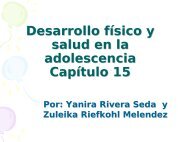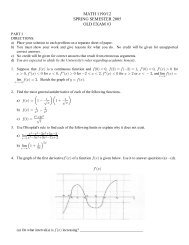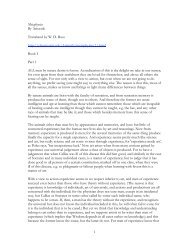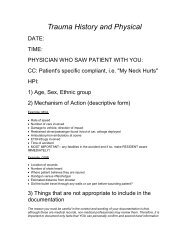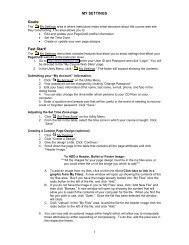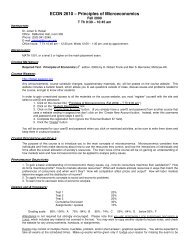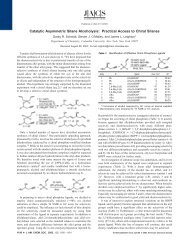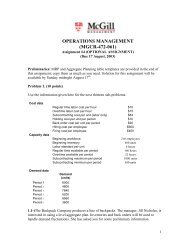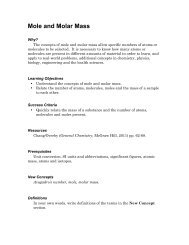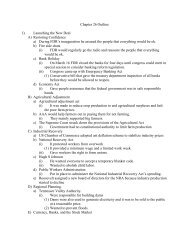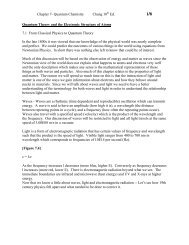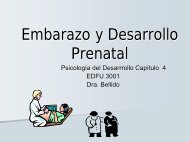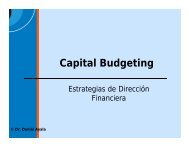Titration of Antacid: “Plop, Plop! Fizz, Fizz! OBJECTIVES ... - PageOut
Titration of Antacid: “Plop, Plop! Fizz, Fizz! OBJECTIVES ... - PageOut
Titration of Antacid: “Plop, Plop! Fizz, Fizz! OBJECTIVES ... - PageOut
Create successful ePaper yourself
Turn your PDF publications into a flip-book with our unique Google optimized e-Paper software.
<strong>Titration</strong> <strong>of</strong> <strong>Antacid</strong>:<br />
<strong>“<strong>Plop</strong></strong>, <strong>Plop</strong>! <strong>Fizz</strong>, <strong>Fizz</strong>!<br />
SCCC Department <strong>of</strong> Natural Sciences<br />
<strong>OBJECTIVES</strong><br />
Experiment 7<br />
1. To understand the concept <strong>of</strong><br />
neutralization<br />
SCCC Department <strong>of</strong> Natural Sciences 2<br />
1<br />
© D.S. Cody<br />
2. To understand the concept <strong>of</strong> molarity<br />
3. To determine the percentage <strong>of</strong><br />
Mg(OH) 2 by titrating milk <strong>of</strong> magnesia<br />
SKILLS<br />
Electronic Balance<br />
(Laboratory Technique II)<br />
Reading a Meniscus<br />
(Laboratory Technique IV)<br />
Buret-<strong>Titration</strong> Technique<br />
(Laboratory Technique VIII)<br />
SCCC Department <strong>of</strong> Natural Sciences 3<br />
© D.S. Cody<br />
© D.S. Cody
Safety Precautions<br />
HAZARD ALERT<br />
Hydrochloric acid is highly<br />
toxic by ingestion or<br />
inhalation and severely<br />
corrosive to skin and eyes.<br />
Wear your goggles at all<br />
times and protective gloves<br />
when handling the HCl.<br />
SCCC Department <strong>of</strong> Natural Sciences 4<br />
Introduction<br />
<strong>Antacid</strong>s<br />
Alka Seltzer<br />
Milk <strong>of</strong> Magnesia<br />
<strong>Antacid</strong> properties <strong>of</strong><br />
magnesium hydroxide<br />
a major ingredient in many<br />
liquid antacid products<br />
SCCC Department <strong>of</strong> Natural Sciences 5<br />
Introduction<br />
<strong>Titration</strong> Method<br />
titrant will be a<br />
standardized solution <strong>of</strong> HCl<br />
sample = milk <strong>of</strong> magnesia<br />
bromocresol purple<br />
indicator<br />
purple in basic solution<br />
yellow in acidic solution<br />
turns lemon-yellow<br />
SCCC Department <strong>of</strong> Natural Sciences 6<br />
© D.S. Cody<br />
© D.S. Cody<br />
© D.S. Cody
Chemical Reaction<br />
Neutralization Reaction<br />
hydrochloric acid reacts with Mg(OH) 2<br />
the products are always a salt and water<br />
salt = magnesium chloride (MgCl)<br />
the balanced equation for this reaction is:<br />
2HCl (aq) + Mg(OH) 2(aq)⇒ MgCl (aq) + 2H 2 O (l)<br />
SCCC Department <strong>of</strong> Natural Sciences 7<br />
Stoichiometry<br />
Neutralization Reaction<br />
2 mole <strong>of</strong> HCl = 1 mole <strong>of</strong> Mg(OH) 2<br />
2HCl (aq) + Mg(OH) 2(aq)⇒ MgCl (aq) + 2H 2 O (l)<br />
SCCC Department <strong>of</strong> Natural Sciences 8<br />
Calculations<br />
number <strong>of</strong> moles <strong>of</strong> HCl<br />
at neutralization the<br />
number <strong>of</strong> moles <strong>of</strong> HCl<br />
equals half the moles <strong>of</strong><br />
Mg(OH) 2<br />
the mass <strong>of</strong> Mg(OH) 2<br />
the % <strong>of</strong> Mg(OH) 2 in milk<br />
<strong>of</strong> magnesia<br />
SCCC Department <strong>of</strong> Natural Sciences 9<br />
© D.S. Cody<br />
© D.S. Cody<br />
© D.S. Cody
Quantitative Relationships<br />
n(moles) <strong>of</strong> HCl = M(Molarity)<br />
× v(volume)<br />
2 moles <strong>of</strong> HCl =<br />
g(grams) <strong>of</strong> Mg(OH) 2 = n(moles) ×<br />
% <strong>of</strong><br />
Mg(OH)<br />
2<br />
=<br />
1 mole <strong>of</strong> Mg(OH) 2<br />
g <strong>of</strong> Mg(OH) 2<br />
g <strong>of</strong> Milk <strong>of</strong> Magnesia<br />
SCCC Department <strong>of</strong> Natural Sciences 10<br />
Procedure<br />
SCCC Department <strong>of</strong> Natural Sciences 11<br />
MW(Molecular<br />
Weight)<br />
© D.S. Cody<br />
1. Clean all the glassware<br />
Rinse well with tap water and then distilled water<br />
2. Rinse one flask with 5 ml <strong>of</strong> standardized HCl<br />
Discard the HCl into waste container<br />
Repeat the rinse/discard procedure two more times<br />
Place ≈ 120 mL <strong>of</strong> HCl in the flask and label it “HCl”<br />
Procedure<br />
SCCC Department <strong>of</strong> Natural Sciences 12<br />
© D.S. Cody<br />
3. Rinse the buret with 5 mL <strong>of</strong> HCl<br />
Allow the solution to drain into the sink through<br />
the buret’s tip.<br />
Repeat this two more times.<br />
Fill the buret with HCl until the solution is above<br />
the zero line.<br />
Open the stopcock and allow the solution to drain<br />
and displace any air bubbles in the tip. The solution<br />
should now be between the zero and two ml line.<br />
© D.S. Cody
Procedure<br />
4. Label three beakers A, B, and C<br />
Shake the bottle <strong>of</strong> milk <strong>of</strong> magnesia well.<br />
Pour ≈ 10 mL <strong>of</strong> this mixture into each <strong>of</strong> the three<br />
beakers.<br />
Reweigh.<br />
5. Add additional distilled water to the beaker to bring<br />
the total volume to ≈ 50 ml for each beaker.<br />
Add five drops <strong>of</strong> bromocresol purple indicator to<br />
each beaker.<br />
SCCC Department <strong>of</strong> Natural Sciences 13<br />
Procedure<br />
SCCC Department <strong>of</strong> Natural Sciences 14<br />
© D.S. Cody<br />
6. Record the initial reading <strong>of</strong> HCl in the buret<br />
It should be between the zero and the two mL line<br />
Titrate the solution in beaker A to the end point<br />
Record the final titration reading <strong>of</strong> HCl.<br />
Refill the buret so that the reading is between the<br />
zero and two mL line<br />
7. Repeat step 6 for beakers B and C<br />
Data and Calculations<br />
Record the weight <strong>of</strong> the beaker<br />
Record the weight <strong>of</strong> the beaker +<br />
milk <strong>of</strong> magnesia<br />
Record initial and final buret<br />
readings<br />
Calculate the endpoint<br />
SCCC Department <strong>of</strong> Natural Sciences 15<br />
© D.S. Cody<br />
© D.S. Cody
Data and Calculations<br />
Calculate the moles <strong>of</strong> HCl<br />
Calculate the moles <strong>of</strong> Mg(OH) 2<br />
Calculate the mass <strong>of</strong> Mg(OH) 2<br />
Calculate the % Mg(OH) 2<br />
Calculate the average % Mg(OH) 2<br />
SCCC Department <strong>of</strong> Natural Sciences 16<br />
17<br />
Cleanup & Waste Disposal<br />
Waste Container<br />
SCCC Department <strong>of</strong> Natural Sciences 18<br />
© D.S. Cody<br />
© D.S. Cody



